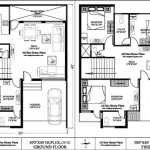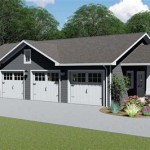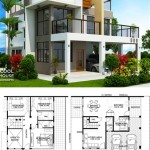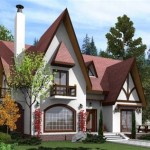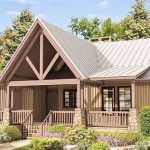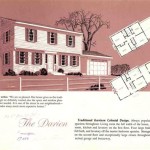Gothic Home Plans: A Journey into Architectural History and Modern Adaptations
Gothic architecture, with its dramatic pointed arches, soaring vaults, and intricate ornamentation, evokes a sense of awe and mystery. Originating in 12th-century France, this style quickly spread across Europe, leaving an indelible mark on religious and secular buildings alike. While grand cathedrals like Notre Dame are perhaps the most iconic examples, the principles of Gothic design can also be applied to residential architecture, resulting in homes that are both visually striking and historically resonant.
Choosing a Gothic home plan involves understanding the key characteristics of this architectural style. Pointed arches are a defining feature, appearing in doorways, windows, and decorative elements. Vaulted ceilings, often ribbed or groined, create a sense of height and grandeur. Large windows, frequently featuring stained glass or intricate tracery, allow ample natural light to illuminate the interior. Ornamentation plays a significant role, with gargoyles, finials, and decorative moldings adding to the overall aesthetic.
Modern Gothic home plans often adapt these historical elements to contemporary living. While maintaining the distinctive visual appeal of Gothic architecture, these plans incorporate modern amenities and functionalities. Open floor plans, updated kitchens, and spacious bathrooms can be seamlessly integrated into the Gothic design. The use of modern materials, such as steel and concrete, can complement traditional materials like stone and wood, creating a harmonious blend of old and new.
Several variations within Gothic architecture offer diverse design possibilities. Early English Gothic, characterized by its lancet windows and simple ornamentation, provides a more restrained aesthetic. The later Decorated Gothic features elaborate window tracery and intricate ornamentation, creating a richer, more ornate appearance. Perpendicular Gothic, prevalent in England, incorporates vertical lines and paneling, lending a sense of height and grandeur.
The size and complexity of Gothic home plans can vary significantly. Smaller cottages can incorporate Gothic details like pointed arch doorways and decorative gables. Larger homes can fully embrace the grandeur of the style, featuring vaulted ceilings, multiple gables, and elaborate window designs. The choice of scale depends on individual preferences and practical considerations such as budget and lot size.
When considering a Gothic home plan, factoring in the location and surrounding environment is essential. A Gothic home nestled amidst a wooded landscape can enhance the sense of mystery and romance associated with the style. Urban settings can also provide a striking backdrop for Gothic architecture, creating a dramatic contrast with surrounding modern buildings. Careful consideration of the surrounding landscape and architectural context can maximize the visual impact of the chosen design.
Building a Gothic home requires specialized craftsmanship and attention to detail. The intricate arches, vaults, and ornamentation demand skilled masons and carpenters. Sourcing appropriate materials, such as stone, wood, and stained glass, is crucial for achieving the authentic Gothic aesthetic. Working with experienced builders specializing in historical or period-appropriate construction is essential for successfully realizing a Gothic home project.
Numerous resources are available for exploring Gothic home plans. Architectural firms specializing in historical styles can offer custom designs tailored to individual needs and preferences. Online platforms provide a vast selection of pre-designed plans, offering a starting point for those seeking inspiration. Historical societies and architectural libraries can provide valuable insights into Gothic architecture and its application to residential design.
Beyond the structural elements, interior design plays a crucial role in creating a cohesive Gothic aesthetic. Furniture choices, color palettes, and decorative elements should complement the architectural style. Dark wood furniture, rich tapestries, and wrought iron accents can enhance the sense of history and drama. Careful consideration of lighting is also essential, as it can highlight the architectural features and create the desired atmosphere.
Maintaining a Gothic home requires ongoing care and attention. Regular inspections and maintenance of the roof, windows, and exterior elements are crucial for preserving the structural integrity of the building. Cleaning and restoration of intricate stonework and ornamentation may require specialized expertise. Proper maintenance ensures the longevity and beauty of the Gothic home, allowing it to stand as a testament to architectural history and craftsmanship.
Adapting Gothic architecture for modern living presents both challenges and opportunities. Balancing historical accuracy with contemporary needs requires careful planning and execution. However, the result can be a unique and captivating home that blends the best of both worlds – the timeless elegance of Gothic design and the comfort and functionality of modern living.

Gothic Revival House Plans Google Search Victorian Vintage Floor

Gothic Mansion Floor Plans Ayanahouse Plan House Dream

Charming Gothic Revival Cottage 1204 Sq Ft Architectural Designs 43002pf House Plans

58 Best Gothic Floor Plans Ideas Vintage House

Gothic Victorian Home Plan With Optional Lower Level Apartment 81786ab Architectural Designs House Plans

The American Gothic 1509 4 Bedrooms And 3 Baths House Designers

Gothic Mansion And Floor Plan Genuine Antique Print For

58 Best Gothic Floor Plans Ideas Vintage House

House Plan 98568 Victorian Style With 3017 Sq Ft 4 Bed 3 Bath

Gothic Revival House Plans Floor For Builders

